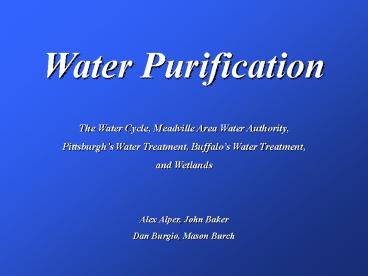Water Purification - PowerPoint PPT Presentation
1 / 14
Title:
Water Purification
Description:
Pittsburgh's Water Treatment, Buffalo's Water Treatment, and Wetlands ... Buffalo Water Purification. Located at the mouth of the Niagara River. Built 1905 ... – PowerPoint PPT presentation
Number of Views:89
Avg rating:3.0/5.0
Title: Water Purification
1
Water Purification
The Water Cycle, Meadville Area Water Authority,
Pittsburghs Water Treatment, Buffalos Water
Treatment, and Wetlands
Alex Alper, John Baker Dan Burgio, Mason Burch
2
The Water Cycle - the most natural purification
system
3
Groundwater
-Scientists estimate groundwater accounts for
more than 95 ofall fresh water available for
use.-Approximately 50 of Americans obtain all
or part of theirdrinking water from
groundwater.-Nearly 95 of rural residents rely
on groundwater for theirdrinking supply.-About
half of irrigated cropland uses
groundwater.-Approximately one third of
industrial water needs are fulfilled byusing
groundwater.-About 40 of river flow nationwide
(on average) depends ongroundwater. http//www.ct
ic.purdue.edu/KYW/Brochures/GroundSurface.html
-Water that remains underground -If soil remains
unpolluted the water is very clean -Soil
naturally purifies water as it runs through
soil removes impurities and kills bacteria
removes sediments and suspended solids
4
Surface Water
-open body of water thats exposed to the
atmosphere (lake, river, stream, etc.) -requires
more treatment because it is openly exposed to
pollution
5
Wetlands
- Also known as swamps, bogs, marshes, sloughs,
etc. - Called Wetlands because the eco-system is moist
for long periods of time due to rain deposits and
retention of water by vegetation. - High Rate of Biodiversity and activity
- Many eco-system services provided by wetlands
throughout the planet - Cheap to maintain unlike human water treatment
plants
6
Process of Wetland Purification
- Vegetation slows water/run off to a standstill
causing the pollutants, eroded soil, TSS (Total
Suspended Solids), nitrogen, organic matter and
phosphorous absorption to be processed into the
system as energy input. The output is cleaner
water and rich in nutrients for the plants - Plants act as anchors and transport
- Sediment eventually buries remaining pollutants
into the deep soil of wetlands
7
Humans VS Nature
- Cheaper to maintain (Catskill Mt. Wetlands in NY
example from class) compared to building and
running a treatment plant - Lacks toxic chemicals like bleach and chlorine to
clean the water - No need for electricity (Fossil Fuels)
- Increased Biodiversity of ecosystem
- Ecosystem services
- Above all the water is clean!!
8
Safe Drinking Water Act
- The Safe Drinking Water Actgives power to the
government to protect public water systems
fromharmful contaminants. - First enacted in 1974 and amended in 1986 and
1996, the Act is administered through regulatory
programs that establish standards and treatment
requirements for drinking water, control
underground injection of wastes that might
contaminate water supplies, and protect ground
water. - The 1974 law established the current
federal-state arrangement in which states may be
delegated primary implementation and enforcement
authority for the drinking water program the
1986 amendments sought to accelerate contaminant
regulation. - The state-administered Public Water Supply
Supervision program remains the basic program for
regulating the Nation's public water systems.
- http//www.csc.noaa.gov/cmfp/reference/Safe_Drinki
ng_Water_Act_1974.htm
9
Meadville Area Water Authority
-provides water for Woodcock Township, Vernon
Township, West Mead Township, and the city of
Meadville -built in 1904 -serves 5400
people -source of water groundwater -has 3
reservoirs, 7 wells (each about 80 ft. deep),
high ground water table (15 ft below ground)
-each well can produce 1 million gallons of
water a day -influenced by the Casawage Valley
and French Valley water systems, but not directly
so we do not need to use surface water
10
Water Pumps
These are two of the seven pumps that pump water
from underground wells to the reservoirs.
11
Water Holding Tanks
Once the water has gone through the purification
system, it is stored in this holding tank.
12
This is used to measure the amount of water in
the holding tanks. If the water goes over ten
feet, or below a set point on the scale, they
know there is a problem of some sort.
13
Pittsburgh Water Purification
http//www.pall.com/water_32956.asp
-surface water (Allegheny River) -water is taken
from source, where it first goes through a screen
that gets rid of leaves, sticks, etc. -chemicals
are added to coagulate smaller particles -static/i
nline mixing to mix the coagulants -clarifier
rids of coagulated sediments and adds a number of
chemicals to clean the water
14
Buffalo Water Purification
- Located at the mouth of the Niagara River
- Built 1905
- Has 740mi distributing mains
- Has 5 steam-driven pumps (1,200 horsepower)

